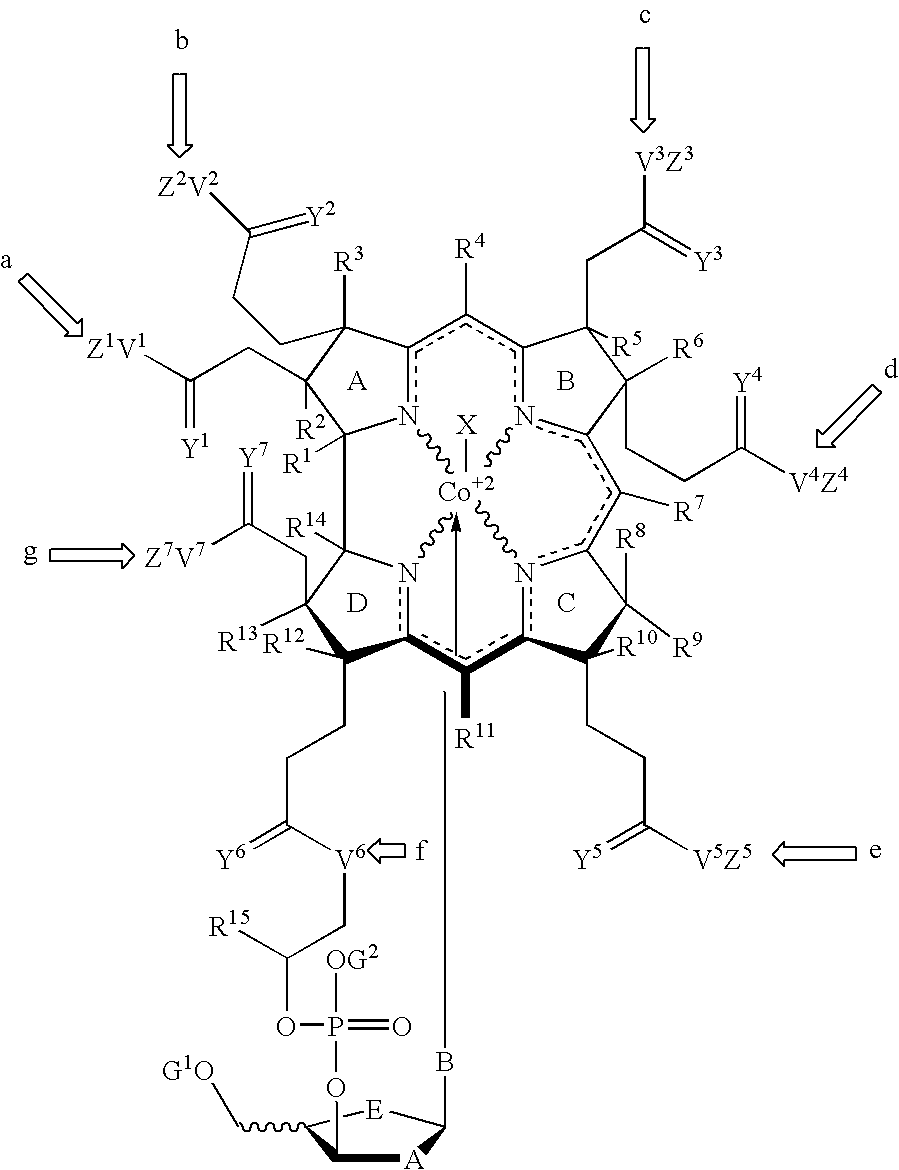Cobalamin mediated delivery of nucleic acids, analogs and derivatives thereof
- Summary
- Abstract
- Description
- Claims
- Application Information
AI Technical Summary
Benefits of technology
Problems solved by technology
Method used
Image
Examples
example
Example 1
Preparation of Cyanocobalamin-b-(4-aminobutyl)amide
[0448] A mixture containing cyanocobalamin-b-carboxylic acid (1.0 g, 0.6 mmol), hydroxybenzotriazole (0.81 g, 6 mmol) and 1,4-diaminobutane dihydrochloride (4.8 g, 30 mmol) in 100 ml of water was adjusted to pH 7.8. 1-Ethyl-3-(3′-dimethylaminopropyl)carbodiimide (1.26 g, 6.6 mmol) was then added, the pH was adjusted to 6.4 and the reaction stirred at room temperature for 24 h. TLC on silica gel using n-butanol-acetic acid water (5:2:3) showed the reaction to be complete. Cyanocobalamin-b-(4-aminobutyl)amide was extracted into 92% aqueous phenol and the phenol layer was washed several times with equal volumes of water. To the phenol extract were added 3 volumes of diethylether and I volume of acetone. The desired cobalamin was removed from the organic phase by several extractions with water. The combined aqueous layers were extracted three times with diethylether to remove residual phenol, concentrated to approximately 20...
example 2
Proposed Preparation of Cyanocobalamin-b-(4-aminobutyl)amide-, Ciprofloxacin-, Levofloxacin-, Ofloxacin- and Sparfloxacin-Cobalamin Conjugates
[0449] A mixture containing cyanocobalamin-b-(4-aminobutyl)amide (0.6 mmol), hydroxybenzotriazole (6 mmol) and the antibiotic agent (e.g. Ciprofloxacin, Levofloxacin or Ofloxacin) (30 mmol) in 100 ml of water is adjusted to pH 7.8. 1-Ethyl-3-(3′-dimethylaminopropyl)carbodiimide (6.6 mmol) is then added, the pH is adjusted to 6.4 and the reaction is stirred at room temperature for 24 h. TLC on silica gel using n-butanol-acetic acid water (5:2:3) shows the reaction to be complete. The product is extracted into 92% aqueous phenol and the phenol layer is washed several times with equal volumes of water. To the phenol extract is added 3 volumes of diethylether and 1 volume of acetone. The desired product is removed from the organic phase by several extractions with water. The combined aqueous layers are extracted three times with diethylether to ...
example 3
Preparation of Methylcobalamin-b-(4-aminobutyl)amide
[0450] Methylcobalamin-b-carboxylic acid (1.0 g, 0.6 mmol) was reacted with diaminobutane dihydrochloride as described above for the cyano derivative. The cobalamin was purified by extraction through phenol (see above) and the resulting aqueous solution was concentrated in vacuo. This solution was chromatographed on AG1-X2 200-400 mesh in the acetate form (20.times.2.5 cm) and the pass through collected. The pass through was concentrated to approximately 20 ml and the desired cobalamin crystallized from aqueous acetone. Yield 920 mg, 88%. Unreacted methylcobalamin-b-carboxylic acid was eluted with 1M acetic acid, concentrated and crystallized from aqueous acetone. Yield 60 mg, 6%.
PUM
| Property | Measurement | Unit |
|---|---|---|
| Fraction | aaaaa | aaaaa |
| Composition | aaaaa | aaaaa |
| Intrinsic viscosity | aaaaa | aaaaa |
Abstract
Description
Claims
Application Information
 Login to View More
Login to View More - R&D
- Intellectual Property
- Life Sciences
- Materials
- Tech Scout
- Unparalleled Data Quality
- Higher Quality Content
- 60% Fewer Hallucinations
Browse by: Latest US Patents, China's latest patents, Technical Efficacy Thesaurus, Application Domain, Technology Topic, Popular Technical Reports.
© 2025 PatSnap. All rights reserved.Legal|Privacy policy|Modern Slavery Act Transparency Statement|Sitemap|About US| Contact US: help@patsnap.com



